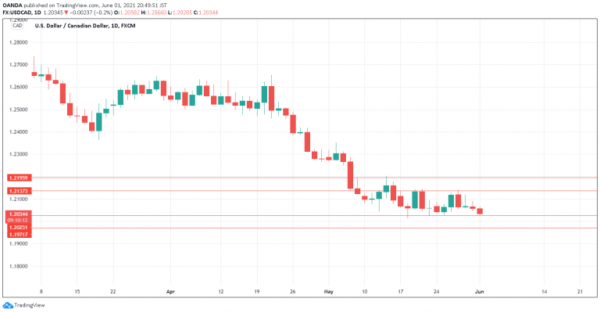The Canadian dollar continues to drift this week. In the European session, USD/CAD is trading at 1.2037, down 0.08% on the day.
Canada GDP projected to accelerate
Canada’s economy is expected to have surged ahead in the first quarter of the year. GDP grew at an impressive rate of 9.8% (YoY) in Q4. The consensus for Q1 stands at 6.8%, which would bring growth close to pre-Covid levels. These GDP figures are impressive, but should be taken with a grain of salt, as that they are in comparison to figures from a year ago, when Covid was at its height and caused a steep economic downturn.
The economic recovery has been fuelled by a resurgence in exports and the strong housing market. Interestingly, the recovery has forged ahead largely without the support of consumer spending, a key driver of economic growth. Strict lockdowns have put a crimp in consumer spending, but pent-up demand is expected to translate into a surge in consumer spending later n the year.
Canada’s Covid vaccine rollout has been sluggish, but infection rates are slowly receding. This has meant that health restrictions have been eased as the economy reopens. In April, the Bank of Canada was the first major central bank to announce a tightening in policy. With the US and UK economies heating up, the Fed and BoE may well follow the BoC example and taper their QE programmes. The BoC has signalled that its key interest rate could rise above the current 0.25% in late 2022. If the BoC continues to drum a hawkish message, the Canadian dollar could break below the 1.20 level, which has held since 2015.
USD/CAD Technical
- USD/CAD faces resistance at 1.2137 and 1.2195
- The pair continues to test support at 1.2025. Below, there is support at 1.1971















